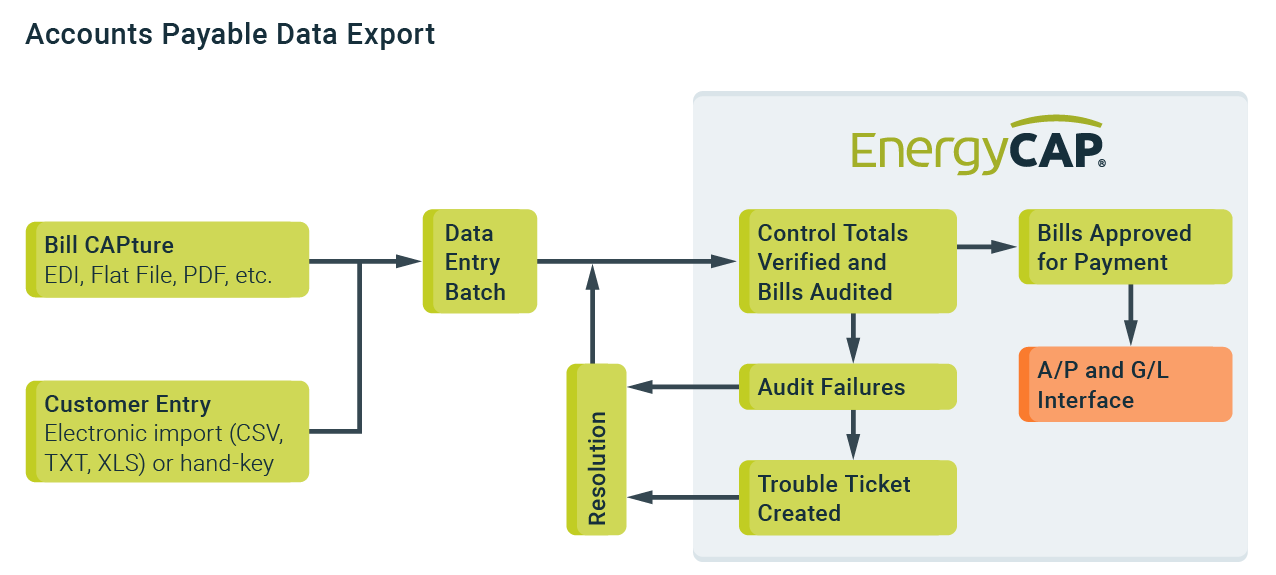 Despite its 20 years as the heavyweight champion of utility bill electronic processing and payment (at least in the eyes of the largest utility vendors), Electronic Data Interchange, or EDI, is still a widely misunderstood utility billing option.
Despite its 20 years as the heavyweight champion of utility bill electronic processing and payment (at least in the eyes of the largest utility vendors), Electronic Data Interchange, or EDI, is still a widely misunderstood utility billing option.
A recent conversation with the energy manager at a mid-sized U.S. city went something like this:
Energy Manager: “We would like you to get our utility bills and import them into EnergyCAP.”
Salesperson: “We can do that. Do you know which electronic invoice formats your vendors offer?”
Energy Manager: “They’re all EDI.”
Salesperson: “All of your vendors offer EDI 810?”
Energy Manager: “I’m not sure about the ‘810’ part, but I can log on to the vendors’ websites and download my bills in a spreadsheet. That’s what we’d like you to do for us. We want to get them in EDI, because it’s faster and gives us all of the information we need.”
Common EDI Misconceptions
The above exchange is very common and brings to light multiple misconceptions regarding EDI 810 and electronic utility bills in general. Before you’re KO’d by a punch from an EDI vendor, let’s clear up some of the confusion.
Misconception #1: All electronic bills are EDI.
Fact: EDI does not refer to all electronic utility bill information sharing. Rather, EDI refers to a very specific closed-loop invoice and payment exchange between the vendor and the customer. There are a lot of EDI standards out there, but EDI 810 is the standard for invoicing and paying utility bills. Other electronic bill formats include CSV, XLS, TXT, XML. If you’re interested in electronic utility bill processing options, it’s a good idea to find out which format is offered by each of your vendors.
Misconception #2: All vendors offer electronic invoices.
Fact: It’s true that most public investor-owned utility vendors offer some type of electronic invoice option, but a very high percentage of municipal and private vendors do not. That means paper invoices are often the only option for utilities such as water, sewer, refuse, recycling, and others.
Misconception #3: EDI invoices are free.
Fact: While the utility vendors usually do not charge a fee for providing EDI 810 invoices, the implementation process can be relatively complex and usually includes implementation costs and on-going processing fees.
Most vendors require that their EDI 810 invoices flow through a Value-Added Network or VAN. The EDI 810 invoices are transmitted by the vendor to the customer’s VAN, and the VAN returns an EDI 997 transmission to acknowledge receipt of the invoices. In effect, the VAN functions as a type of electronic post office and typically charges a per-invoice fee for the service.
A substantial percentage of utility vendors also require electronic payment – an EDI 820 transmission – as part of the EDI invoicing service, so coordination with the Accounts Payable Department is also frequently required.
Organizations that are considering the transition from paper bills to EDI 810 should be aware of the implementation effort and take it into account.
Misconception #4: EDI bills match the paper bills.
Fact: Electronic invoices, regardless of format, provide the same detailed information that is detailed on the paper bills, right? Unfortunately, that’s not the case in a high percentage of cases.
EnergyCAP, Inc. (ECI) processes thousands of bills every month through our Bill CAPture service, and we find all too frequently that the electronic invoices do not match the paper bills. EDI is fundamentally an electronic accounting payment process and not an energy management tool. Even non-EDI electronic invoices, especially those provided in a spreadsheet format, provide only summary billing data, rather than the detailed use, demand, and cost information desired by most energy managers. We have also encountered scenarios where the electronic invoices are simply not correct, as many vendors fail to update them to reflect rate schedule updates and other billing changes that make it to their paper-based processing systems.
Misconception #5: You can receive EDI bills and paper bills.
Fact: It’s EDI 810 or paper. Those are typically the only options offered by utility vendors. While we have seen the rare instance where a vendor will provide both options, it is the norm for vendors to discontinue paper bills once EDI is fully implemented.
As outlined above, many vendors will require a fully-electronic process. In other words, if they’re going to invoice you electronically, they expect to get paid electronically, typically via an Automated Clearinghouse (ACH) process. The requirement reinforces the importance of including your Finance or Accounting Department in any conversations regarding a move to EDI invoicing.
Misconception #6: All EDI is the same.
Fact: While EDI 810 is the recognized ANSI standard for utility bills, the “standard” part is applied loosely.
When EDI 810 was established in the 1990s, it was a combined effort of several large investor-owned utilities (IOUs). Each vendor had its own well-established billing system, and none wanted to make a large investment in revamping its billing system to meet a uniform standard. So, the new “standard” offered a large amount of flexibility to make it easier to for each vendor to implement. The result is that EDI 810 invoice formats can and will vary widely from vendor to vendor.
If your organization is served by multiple vendors, as most are, you should expect that each vendor’s EDI 810 invoices will be uniquely structured and will require a unique reformatting process to convert to a format that can be imported into your energy management system (e.g., EnergyCAP) or A/P system.
Despite the inherent complexities of processing EDI invoices, a high number of EnergyCAP customers have done so successfully for many years. Once the process is implemented, it’s relatively easy to maintain, and the low per-bill processing fee often outweighs the challenges outlined above.
That said, technological advances have elevated another bill processing alternative to the forefront. Read on to learn more!
Optical Character Recognition (OCR)—The Contender
EDI may be the historic heavyweight champion for utility bill processing, but there is a new contender in the ring these days for utility billing data acquisition.
In May 2014, just 27 months ago, an ECI blog post titled “5 Options to Avoid Hand-Keying Utility Bills” stated the following about OCR: “[OCR] data collection is not as reliable as a flat file or EDI import, but can be effective if a consistent audit process is used to detect read errors.”
Scratch that. Today, due to tremendous technological improvements, OCR bill processing is the preferred method of our Bill CAPture staff for processing tens of thousands of utility bills monthly. Here’s why…
- Almost everyone still receives paper utility bills. And many organizations already scan the paper bills for storage as PDF files. So, no major organizational process changes are typically required to implement OCR processing.
- Paper bills are considered by utility vendors to be the bill of record. They provide detailed information that may not be included in electronic invoices, and energy managers know “the devil is in the details.”
- All of your vendor bills can be included, since all vendors offer paper billing.
- If you researched OCR in the past and were concerned about data accuracy, you can put your fears to rest. Today’s OCR technology is accurate, very accurate.
- There’s no need to develop and maintain a custom electronic file reformatter for each utility vendor.
- EnergyCAP users get the additional benefit of being able to view the PDF image of the actual utility bill from within the EnergyCAP application – a permanent image record at your fingertips.
- Compliance with established accounting practices is easier since you can adhere to any paper record requirements your organization may have in place.
- Your Finance Department, if desired, can continue to hand-key required billing details into the A/P system for payment.
Note: We recommend that EnergyCAP users streamline the bill processing workflow via our optional A/P Export module. The process makes it easy to export billing details from EnergyCAP–after they have been audited and approved–in a format that is import-ready for the A/P system. Then no one has to hand-key utility bill data.

Most organizations don’t maintain an internal OCR operation, so the OCR service is usually outsourced to a bill processing service provider, such as ECI’s Bill CAPture service.
OCR Service providers typically offer multiple service levels, and fees vary by monthly transaction volume, processing time requirements, and, potentially, other factors. That said, the per-bill processing fee is almost always substantially lower than the in-house cost, and your data entry staff will be free to focus on more valuable utility bill analysis and energy management tasks.

EDI or OCR – Which Option Is Best For You?
Each organization is unique, and no single bill processing solution is right for everyone. Many organizations take a hybrid approach, relying on a combination of formats.
Fortunately, many options are available, and here at EnergyCAP, we’re happy to help you determine which option or combination will meet your needs in the most efficient and cost-effective manner.
{{cta(‘d9feac50-660b-4737-9903-c00f9d7ed0fc’)}}
 Best-in-class portfolio-level energy and utility bill data management and reporting.
Best-in-class portfolio-level energy and utility bill data management and reporting.
 Real-time energy and sustainability analytics for high-performance, net-zero buildings.
Real-time energy and sustainability analytics for high-performance, net-zero buildings.
 A holistic view of financial-grade scope 1, 2, and 3 carbon emissions data across your entire business.
A holistic view of financial-grade scope 1, 2, and 3 carbon emissions data across your entire business.
 Energy and sustainability benchmarking compliance software designed for utilities.
Energy and sustainability benchmarking compliance software designed for utilities.
 Despite its 20 years as the heavyweight champion of utility bill electronic processing and payment (at least in the eyes of the largest utility vendors), Electronic Data Interchange, or EDI, is still a widely misunderstood utility billing option.
Despite its 20 years as the heavyweight champion of utility bill electronic processing and payment (at least in the eyes of the largest utility vendors), Electronic Data Interchange, or EDI, is still a widely misunderstood utility billing option.



